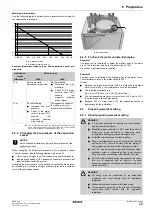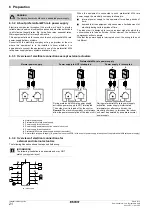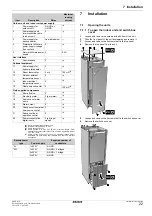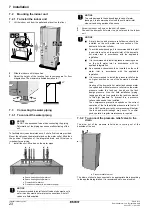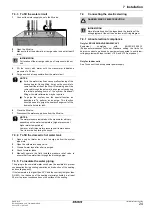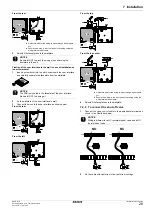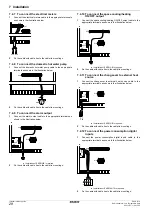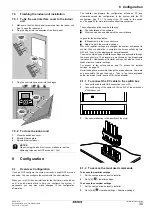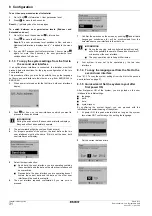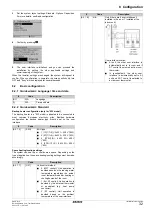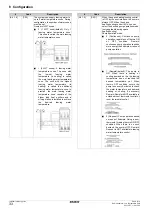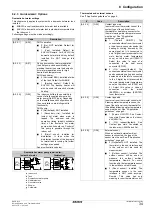
Installer reference guide
19
EHVH/X16
Daikin Altherma - Low Temperature Split
4P313777-1 – 2012.05
6 Preparation
Q
Only use materials that are compatible with water used in the
system and with the materials used in the indoor unit.
Q
Check that all components in the field piping can withstand the
water pressure and water temperature.
Q
When using non-brass metallic piping, insulate the brass and
non-brass properly so that they do NOT make contact with each
other. This to prevent galvanic corrosion.
Q
Never use Zn-coated parts in the water circuit. Because the
unit's internal water circuit uses copper piping, excessive
corrosion may occur.
Q
Only use appropriate tooling to handle brass, which is a soft
material. If NOT, pipes will get damaged.
Q
Select the water piping diameter in relation to the required water
flow and the available external static pressure of the pump. See
"14 Technical data" on page 61 for the external static pressure
curves of the indoor unit.
Q
You can find the minimum required water flow for the indoor unit
operation in the following table. When the water flow is lower,
flow error 7H will be displayed and the indoor unit will be
stopped.
Q
When using a 2-way valve in the water circuit, the maximum
change-over time of the valve must be 60 seconds.
Q
It is strongly recommended to install an additional filter on the
heating water circuit. Especially to remove metallic particles
from the filed heating piping, it is advised to use a magnetic or
cyclone filter, which can remove small particles. Small particles
may damage the unit and will NOT be removed by the standard
filter of the heat pump system.
Q
If air, moisture or dust gets into the water circuit, problems may
occur. To prevent this:
Q
Only use clean pipes
Q
Hold the pipe end downwards when removing burrs.
Q
Cover the pipe end when inserting it through a wall, to
prevent dust and/or particles entering the pipe.
Q
Use a decent thread sealant to seal connections.
Q
For safety reasons, it is NOT allowed to add any kind of glycol to
the water circuit.
Q
To avoid stagnation of water, it is important that the storage
capacity of the domestic hot water tank meets the daily
consumption of domestic hot water.
In cases where during longer periods of time there is no
consumption of hot water, the equipment must be flushed with
fresh water before usage.
The disinfection function provided on the equipment is specified
in the operation manual of the indoor unit.
Q
It is recommended to avoid long runs of piping between the
domestic hot water tank and the hot water end point (shower,
bath,…) and to avoid dead ends.
Q
The installation must be in compliance with the applicable
legislation and may require additional hygienic installation
measures.
Q
In accordance with the applicable legislation, it may be
necessary to install thermostatic mixing valves.
Q
Immediately after installation, the domestic hot water tank must
be flushed with fresh water. This procedure must be repeated at
least once a day the first 5 consecutive days after installation.
Q
In accordance with the applicable legislation, it may be required
to connect a recirculation pump in between the hot water end
point and the recirculation connection of the domestic hot water
tank.
6.2.2 Formula to calculate the expansion vessel
pre-pressure
The pre-pressure (Pg) of the vessel depends on the installation
height difference (H):
Pg=0.3+(H/10) (bar)
6.2.3 To check the water volume
The indoor unit has an expansion vessel of 10 litre with a factory set
pre-pressure of 1 bar.
To make sure that the unit operates properly:
Q
You must check the minimum and maximum water volume.
Q
You might need to adjust the pre-pressure of the expansion
vessel.
Minimum water volume
Check that the total water volume in the installation is minimum
20 liter, the internal water volume of the indoor unit NOT included.
Model
Minimum water flow (l/min)
04
5
08+16
11
a
Recirculation connection
b
Hot water connection
c
Shower
d
Recirculation pump
INFORMATION
In critical processes, or in rooms with a high heat load,
extra water might be required.
NOTICE
When circulation in each space heating loop is controlled
by remotely controlled valves, it is important that the
minimum water volume is guaranteed, even if all of the
valves are closed.
a
Outdoor unit
b
Indoor unit
c
Heat exchanger
d
Backup heater
e
Pump
f
Shut-off valve
g
Collector (field supply)
h
By-pass valve (field supply)
FHL1...3
Floor heating loop (field supply)
T1...3
Individual room thermostat (optional)
M1...3
Individual motorised valve to control loop FHL1...3 (field
supply)
c
d
a
b
FHL1
FHL2
FHL3
M1
T1
M2
T2
M3
T3
f
d
c
b
a
f
g
h
e
Содержание EHVH16S18CA
Страница 84: ...4P313777 1 2012 05 Copyright 2012 Daikin ...
















